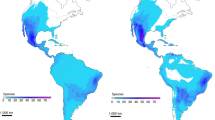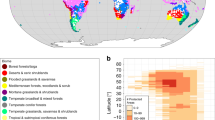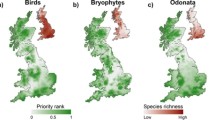Abstract
The Cactaceae is considered one of the most threatened taxa in the world. However, the extent to which climate change could compromise the conservation status of this group has rarely been investigated. The present study advances this issue under three specific aims: (1) to assess the impact of climate change on the distribution of endemic cacti species in the Baja California Peninsula (n = 40), (2) to study how the impact of climate change is distributed in this group according to the species’ conservation status, and (3) to analyze how these impacts are organized from a biogeographical and functional perspective. We addressed these objectives under three socioeconomic emission pathways (RCP 2.6, 4.5, and 8.5), and using two extreme migration scenarios: full climate change tracking and no migration. Altogether, all socioeconomic emission pathways under the two extreme migration scenarios show consistency regarding the identity of the species most vulnerable to climate change, and depict a discrepant future scenario that has, on one hand, species with large potential habitat gains/stability (winners); and on the other, species with large habitat reductions (losers). Our work indicates that winner species have a tropical affinity, globose growth, and includes most of the currently threatened species, whereas loser ones are in arid and Mediterranean systems and are mostly non-threatened. Thus, current and future threat factors do not overlap in the biogeographic and taxonomic space. That reveals a worrisome horizon at supraspecific levels in the study area, since the total number of threatened species in the future might largely increase.






Similar content being viewed by others
References
Abdelaal M, Fois M, Fenu G, Bacchetta G (2019) Using MaxEnt modeling to predict the potential distribution of the endemic plant Rosa arabica Crép. in Egypt. Ecol Inform 50:68–75
Aiello-Lammens ME, Boria RA, Radosavljevic A, Vilela B, Anderson RP (2015) spThin: an R package for spatial thinning of species occurrence records for use in ecological niche models. Ecography 38(5):541–545
Anadón JD, Graciá E, Botella F, Giménez A, Fahd S, Fritz U (2015) Individualistic response to past climate changes: niche differentiation promotes diverging Quaternary range dynamics in the subspecies of Testudo graeca. Ecography 38(9):956–966
Anderson RP, Raza A (2010) The effect of the extent of the study region on GIS models of species geographic distributions and estimates of niche evolution: preliminary tests with montane rodents (genus Nephelomys) in Venezuela. J Biogeogr 37(7):1378–1393
Angert AL, Crozier LG, Rissler LJ, Gilman SE, Tewksbury JJ, Chunco AJ (2011) Do species’ traits predict recent shifts at expanding range edges? Ecol Lett 14(7):677–689
Araújo MB, Alagador D, Cabeza M, Nogués-Bravo D, Thuiller W (2011) Climate change threatens European conservation areas. Ecol Lett 14(5):484–492
Auer SK, King DI (2014) Ecological and life-history traits explain recent boundary shifts in elevation and latitude of western North American songbirds. Glob Ecol Biogeogr 23(8):867–875
Barthlott W, Burstedde K, Geffert JL, Ibisch PI, Korotkova N, Miebach A, Rafiqpoor MD, Stein A, Mutke J (2015) Biogeography and biodiversity of cacti. Schumannia 7:208
Barbet-Massin M, Jiguet F, Albert CH, Thuiller W (2012) Selecting pseudo-absences for species distribution models: how, where and how many? Methods Ecol Evol 3:327–338
Barve N, Barve V, Jiménez-Valverde A, Lira-Noriega A, Maher SP, Peterson AT, Villalobos F (2011) The crucial role of the accessible area in ecological niche modeling and species distribution modeling. Ecol Model 222(11):1810–1819
Broennimann O, Thuiller W, Hughe G, Migdley GF, Alekemade RJM, Guisan A (2006) Do geographic distribution, niche property and life form explain plants’ vulnerability to global change? Glob Change Biol 12:1079–1093
Brown JH (1995) Macroecology. The University of Chicago Press, Chicago
Buckley LB, Kingsolver JG (2012) Functional and phylogenetic approaches to forecasting species’ responses to climate change. Annu Rev Ecol Evol Syst 43:205–226
Burnham KP, Anderson DR (1998) Model selection and inference: a practical information-theoretical approach. Springer, New York
Butler CJ, Wheeler EA, Stabler LB (2012) Distribution of the threatened lace hedgehog cactus (Echinocereus reichenbachii) under various climate change scenarios. J Torrey Bot Soc 139(1):46–55
Cactaceae in GBIF Secretariat (2019) GBIF Backbone Taxonomy. Checklist dataset https://doi.org/10.15468/39omei. Accessed via GBIF.org on December 2014.
Carrillo-Angeles IG, Suzán-Azpiri H, Mandujano MC, Golubov J, Martínez-Ávalos JG (2016) Niche breadth and the implications of climate change in the conservation of the genus Astrophytum (Cactaceae). J Arid Environ 124:310–317
Corlett RT, Westcott DA (2013) Will plant movements keep up with climate change? Trends Ecol Evol 28(8):482–488
Comisión Nacional Forestal (2014) Inventario Nacional Forestal y de Suelos. CONAFOR, Guadalajara, Jal., México
CONABIO (2015) Red Mundial de Información sobre Biodiversidad http://www.conabio.gob.mx/remib_ingles/doctos/remib_ing.html. Downloaded on December 2017
Cortes L, Domínguez I, Lebgue T, Viramontes O, Melgoza A, Pinedo C, Camarillo J (2014) Variation in the distribution of four cacti species due to climate change in Chihuahua, Mexico. Int J Environ Res Public Health 11(1):390–402
Dávila P, Téllez O, Lira R (2013) Impact of climate change on the distribution of populations of an endemic Mexican columnar cactus in the Tehuacán-Cuicatlán Valley, Mexico. Plant Biosyst Int J Deal Asp Plant Biol 147(2):376–386
Dawson TP, Jackson ST, House JI, Prentice IC, Mace GM (2011) Beyond predictions: biodiversity conservation in a changing climate. Science 332:53–58
Elith J, Phillips SJ, Hastie T, Dudík M, Chee YE, Yates CJ (2011) A statistical explanation of MaxEnt for ecologists. Divers Distrib 17(1):43–57
Erasmus BFN, Van Jaarsweld AS, Chown SL, Kshatriya M, Wessels KJ (2002) Vulnerability of South African animal taxa to climate change. Glob Change Biol 8:679–693
Estrada A, Meireles C, Morales-Castilla I, Poschlod P, Vieites D, Araújo MB, Early R (2015) Species’ intrinsic traits inform their range limitations and vulnerability under environmental change. Glob Ecol Biogeogr 24(7):849–858
Franklin J (2010) Moving beyond static species distribution models in support of conservation biogeography. Divers Distrib 16(3):321–330
Galante PJ, Alade B, Muscarella R, Jansa SA, Goodman SM, Anderson RP (2018) The challenge of modeling niches and distributions for data-poor species: a comprehensive approach to model complexity. Ecography 41(5):726–736
García RA, Araújo MB, Burgess ND, Foden WB, Gutsche A, Rahbek C, Cabeza M (2014) Matching species traits to projected threats and opportunities from climate change. J Biogeogr 41(4):724–735
Goettsch B, Hilton-Taylor C, Cruz-Piñón G et al (2015) High proportion of cactus species threatened with extinction. Nat Plants 15142:1–7
González-Abraham Ch, Garcillán PP, Ezcurra E (2010) Ecoregions of Baja California peninsula: a synthesis. Boletín de la Sociedad Botánica de México 87:69–82
Gillson L, Dawson TP, Jack S, McGeoch MA (2013) Accommodating climate change contingencies in conservation strategy. Trends Ecol Evol 28(3):135–142. https://doi.org/10.1016/j.tree.2012.10.008
Hijmans RJ, Cameron SE, Parra JL, Jones PG, Jarvis A (2005) Very high resolution interpolated climate surfaces for global land areas. Int J Climatol J R Meteorol Soc 25(15):1965–1978 (IUCN 2018)
IPCC (2013) Climate change 2013: the physical science basis. In: Stocker TF, Qin D, Plattner G-K, Tignor M, Allen SK, Boschung J, Nauels A, Xia Y, Bex V, Midgley PM (eds) Contribution of Working Group I to the Fifth Assessment Report of the Intergovernmental Panel on Climate Change. Cambridge University Press, Cambridge, United Kingdom and New York, NY, USA, 1535 pp. doi:https://doi.org/10.1017/CBO9781107415324
IUCN (2019) The IUCN Red List of Threatened Species. Version 2019-3. https://www.iucnredlist.org. Downloaded on December 2019
Johnson CN (1998) Species extinction and the relationship between distribution and abundance. Nature 394(6690):272
Lenoir J, Svenning JC (2015) Climate-related range shifts—a global multidimensional synthesis and new research directions. Ecography 38(1):15–28
Liu C, White M, Newell G (2013) Selecting thresholds for the prediction of species occurrence with presence-only data. J Biogeogr 40(4):778–789
Marmion M, Parviainen M, Luoto M, Heikkinen RK, Thuiller W (2009) Evaluation of consensus methods in predictive species distribution modeling. Divers Distrib 15(1):59–69
Midgley GF, Hannah L, Millar D, Thuiller W, Booth A (2003) Developing regional and species-level assessments of climate change impacts on biodiversity in the Cape Floristic Region. Biol Conserv 112:87–97
Midgley GF, Hannah L, Rutherford MC, Powrie LW (2002) Assessing the vulnerability of species richness to anthropogenic climate change in a biodiversity hotspot. Glob Ecol Biogeogr 11:445–451
Morin X, Thuiller W (2009) Comparing niche-and process-based models to reduce prediction uncertainty in species range shifts under climate change. Ecology 90(5):1301–1313
Mourelle C, Ezcurra E (1997) Differentiation diversity of Argentine cacti and its relationship to environmental factors. J Veg Sci 8:547–558
Parra JL, Monahan WB (2008) Variability in 20th century climate change reconstructions and its consequences for predicting geographic responses of California mammals. Glob Change Biol 14:2215–2231
Pearson RG, Raxworthy CJ, Nakamura M, Townsend Peterson A (2007) Predicting species distributions from small numbers of occurrence records: a test case using cryptic geckos in Madagascar. J Biogeogr 34(1):102–117
Pearson RG, Dawson TP (2003) Predicting the impacts of climate change on the distribution of species: are bioclimate envelope models useful? Glob Ecol Biogeogr 12(5):361–371
Phillips SJ, Anderson RP, Schapire RE (2006) Maximum entropy modelling of species geographic distributions. Ecol Model 190:231–259
Pöyry J, Luoto M, Heikkinen RK, Kuussaari M, Saarinen K (2009) Species traits explain recent range shifts of Finnish butterflies. Glob Change Biol 15:732–743
Rebman J (2001) Succulent diversity in Lower California Mexico. Cactus Succul J (US) 73:131–138
Riahi K, Rao S, Krey V, Cho C, Chirkov V, Fischer G, Kindermann G, Nakicenovic N, Rafaj P (2011) RCP 8.5—a scenario of comparatively high greenhouse gas emissions. Clim Change 109(1–2):33
Riemann H, Ezcurra E (2005) Plant endemism and natural protected areas in the peninsula of Baja California, Mexico. Biol Conserv 122(1):141–150
Santos-Díaz MS, Pérez-Molphe-Balch E, Ramírez-Malagón R, Núñez-Palenius HG, Ochoa-Alejo N (2010) Mexican threatened cacti: current status and strategies for their conservation. In: Tepper GH (ed) Species diversity and extinction. Nova Science Publishers, Inc., New York, pp 1–60
Senay SD, Worner SP, Ikeda T (2013) Novel three-step pseudo-absence selection technique for improved species distribution modelling. PLoS One 8(8):e71218
Shreve F, Wiggins I (1964) Vegetation and flora of the Sonoran Desert, 1. Stanford University Press, Stanford, California
Téllez-Valdés O, Vila-Aranda PD (2003) Protected areas and climate change: a case study of the cacti in the Tehuacán-Cuicatlán biosphere reserve, México. Conserv Biol 17:846–853
Thomas CD, Hill JK, Anderson BJ, Bailey S, Beale CM, Bradbury RB, Yardley T (2010) A framework for assessing threats and benefits to species responding to climate change. Methods Ecol Evol 2(2):125–142
Thuiller W, Lavorel S, Araujo MB (2005) Niche properties and geographic extent as predictors of species sensitivity to climate change. Glob Ecol Biogeogr 14:347–357
Thuiller W, Lavorel S, Sykes MT, Araujo MB (2006) Using niche based modelling to assess the impact of climate change on tree functional diversity in Europe. Divers Distrib 12:49–60
Thuiller W, Guéguen M, Renaud J, Karger DN, Zimmermann NE (2019) Uncertainty in ensembles of global biodiversity scenarios. Nat Commun 10(1):1446
Wiggins IL (1980) Flora of Baja California. Stanford University Press, Standford
Williams SE, Shoo LP, Isaac JL, Hoffmann AA, Langham G (2008) Towards an integrated framework for assessing the vulnerability of species to climate change. PLoS Biol 6(12):e325
Wisz MS, Hijmans RJ, Li J, Peterson AT, Graham CH, Guisan A, NCEAS Predicting Species Distributions Working Group (2008) Effects of sample size on the performance of species distribution models. Divers Distrib 14(5):763–773
Acknowledgements
To the herbarium curators: José Delgadillo, Jose Luis León and Jon Rebman, who additionally contributed with suggestions as a cacti expert. To Pedro Peña Garcillán, for his observations throughout the development of this research. Raúl Martinez Rincón, for the support in the programming process and the statistical analysis of the data. To the research group of “Ecological modeling for global change research laboratory”, especially to Pedro Abellán Rodenas for the support in the process of model development and data analysis, and Aishwarya Bhattacharjee for the feedback in English language editing and manuscript proofreading.
Author information
Authors and Affiliations
Corresponding author
Additional information
Communicated by Hsiao-Hsuan Wang.
Publisher's Note
Springer Nature remains neutral with regard to jurisdictional claims in published maps and institutional affiliations.
Electronic supplementary material
Below is the link to the electronic supplementary material.
Rights and permissions
About this article
Cite this article
Benavides, E., Breceda, A. & Anadón, J.D. Winners and losers in the predicted impact of climate change on cacti species in Baja California. Plant Ecol 222, 29–44 (2021). https://doi.org/10.1007/s11258-020-01085-2
Received:
Accepted:
Published:
Issue Date:
DOI: https://doi.org/10.1007/s11258-020-01085-2




